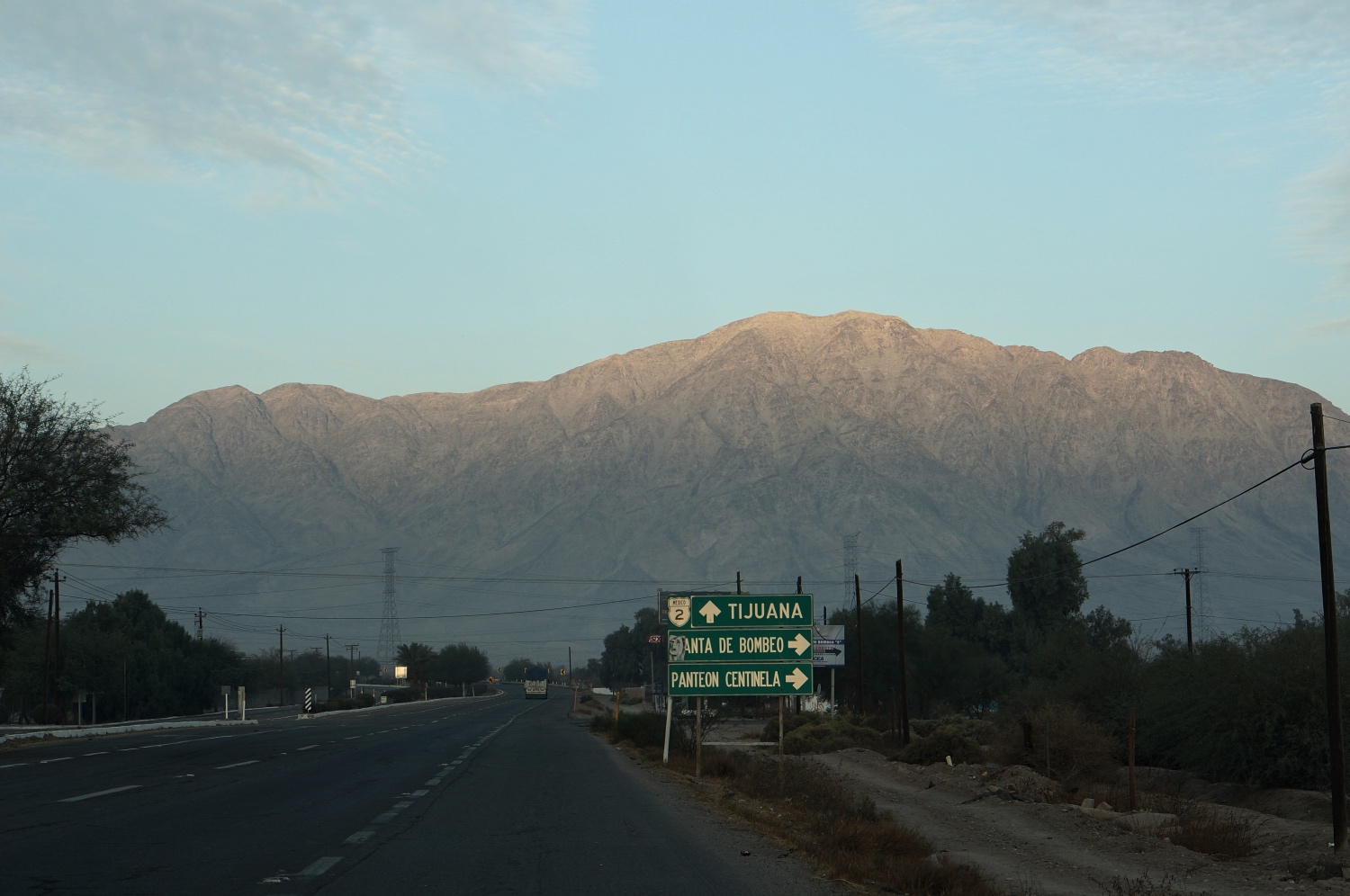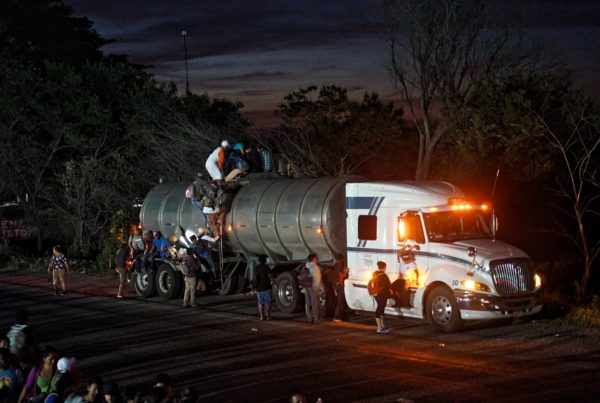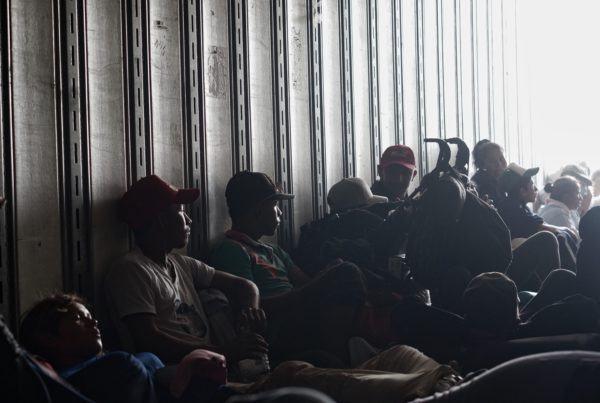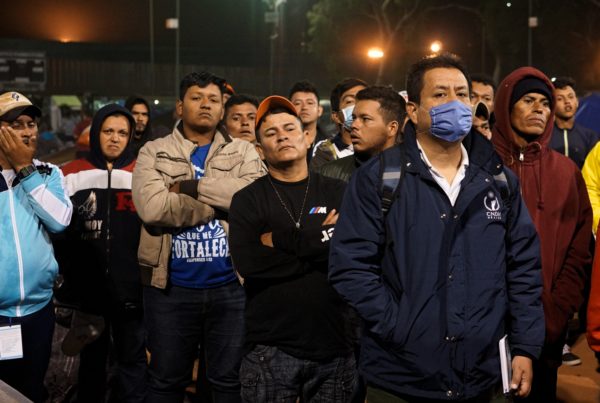The next day we begin the last leg of the journey to Tijuana. La Rumorosa highway crosses the sunrise-golden Sierra de Juárez Mountains of Baja California. The road climbs between loose rock outcrops which at certain points fall away to reveal a view of a vast, scrubby desert which stretches to the US border and beyond, fading into the hazy horizon. We pass the mountain village of Tecate, where the beer was originally brewed and named after. The rusty brown border wall dog legs between mountains marking out the arbitrary line between Mexico and USA. Less than two hundred years earlier that used to be Mexican territory, before the US invaded. And then the road beelines for Tijuana and the west coast.
There were many points on the journey north to the border where I marvelled at the beauty of the Mexican landscape. The road from Mexicali to Tijuana does not disappoint. I have been travelling with a group of youngsters from Guatemala and Honduras which includes Jenni, Christian and David who have never had the chance to travel outside their countries before, even if it is in a caravan such as this. David says the experience has been marvellous. He has enjoyed seeing landscapes that he previously only knew from the Internet or television. I can’t help but be caught up in their youthful wanderlust.
For the members of the Exodus there is a sense of achievement in reaching Tijuana. They have travelled more than 4,000 kilometres in more than 30 days. They marched through Chiapas, the land of the jaguar, past the agave fields of Oaxaca, and into Veracruz where they feared Los Zetas cartel operations. In between Veracruz and Mexico City around 100 people were supposedly kidnapped while travelling in 2 trucks (although this still has not been confirmed). After a brief hiatus in Mexico City they moved rapidly on long, exhausting bus journeys through the states of Jalisco, Nayarit, Sinaloa, Sonora and finally Baja California. But with the Trump administration sending military troops to the border there is no idea of what to expect at the border.
Anna Joseph is an immigration lawyer from New York who works for the institute for women and migration (IMUMI) in Mexico City. She tells me it’s going to be difficult for the people in the caravan to obtain asylum in the US.
“A lot of people think that because they are fleeing very legitimate violence and because they are coming with their young children they will be welcomed, which is how it should be, but that is not the case. A lot of people have very legitimate claims but because of the current policy they probably won’t make it through,” Anna says.
She cites recent attempts by Donald Trump and attorney general Jeff Sessions to stop granting asylum to victims of domestic abuse and gang violence.
“I was just speaking with a woman whose ex-partner shot one of her children. With another president she would have a strong claim but not now,” she says.
It is unclear whether the Trump administration has the power to enact such controversial measures and there will be lots of litigation against the proposal, but that is the situation people who are in the caravan will meet when they arrive at the border.
Anna explains that when the people of the caravan first arrive at the US border in Tijuana, those who intend to ask for asylum will wait outside a port of entry. The wait time for applications to be accepted is variable but it generally takes weeks. Those people applying for asylum will go to a short-term detention centre where they will be interviewed to assess whether their fear is “credible.”
“There is a detention centre called “the refrigerator” because it’s so cold. People faint, there is not enough food, there is not enough water, there aren’t enough blankets. It’s a really horrible situation,” Anna says.
If a person fails the test for “credible fear” they will be detained and subjected to deportation.
“Most people probably won’t make it past their credible fear interview because a lot of people adjudicating these claims think people are lying,” Anna says.
However, Anna is also concerned that even if people have legitimate claims they may not be able to express them properly.
Those who pass that screening are given a court date, often years in the future, at which they can make their case for asylum. Most people waiting for asylum proceedings are allowed out of detention. However, the Trump administration is trying to change legislation to allow the detention of asylum seekers for the duration of this process. This could be up to three years.
“Trump says that people don’t return for their hearings but that’s not what the statistics show. He is trying to detain everyone as part of a strategy to deter future caravans.”
Anna expects the processing of the caravans to be worse due to the media attention they have generated and because Trump has been using it as a political ploy.
“We don’t know what they’re planning to do. My personal guess is that he will detain as many people as possible rather than allowing them to stay in the community with people who might be able to support them.”
While travelling La Rumorosa highway, my Guatemalan friend and member of the caravan, Jenni, tells me she is excited to arrive in Tijuana but worried about what is to come. She is worried about how she can enter the US and where they will stay while they wait. In addition to that, border towns are known for drug cartel operations.
“Are you afraid of what might happen at the border?” I ask.
“Nobody is going to do anything to me,” she says. “Nobody can touch me.”
“Are you invincible?” I ask.
“God does not let them touch me,” she replies.



